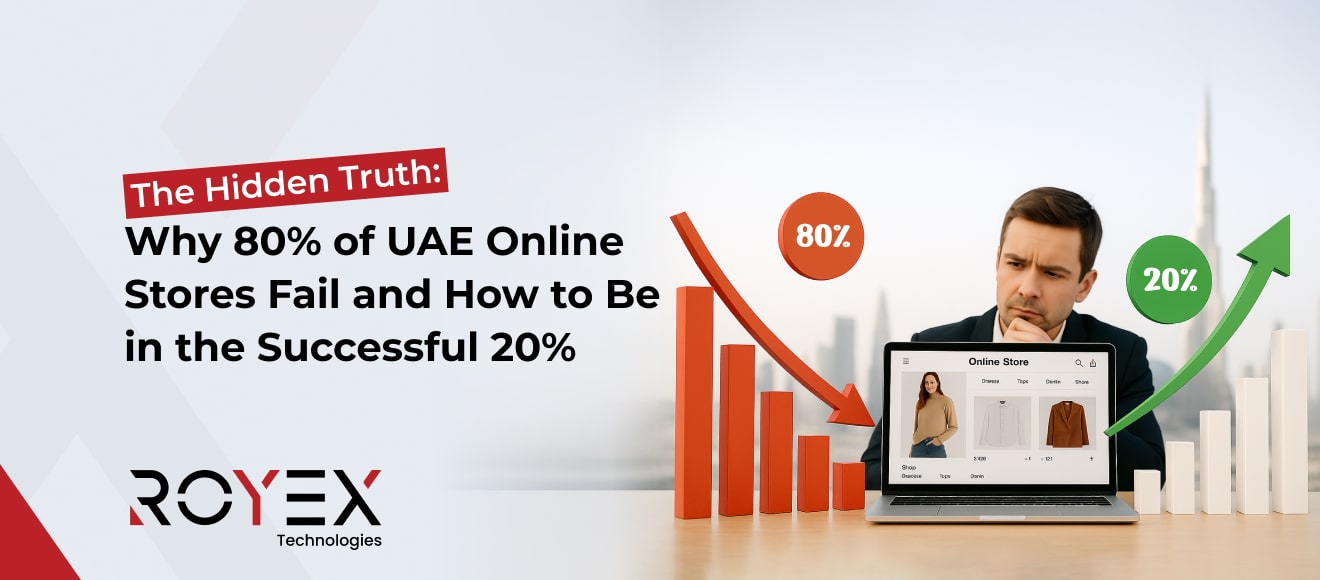
The Hidden Truth: Why 80% of UAE Online Stores Fail — and How to Be in the Successful 20%
The UAE market looks irresistible: high smartphone penetration, big spending tourists, sophisticated logistics infrastructure and growing local demand. Yet a surprisingly large proportion of new online stores never make it. Many operators either burn through cash, or plateau on revenue while margins disappear. This article maps the real reasons behind that attrition — with UAE-specific context, data-driven explanations, and an actionable playbook you can use to build a resilient, profitable e-commerce business that belongs in the successful 20%.
What “80% fail” actually means (and why that figure shows up everywhere)
You’ve seen headlines like “80% of e-commerce businesses fail” or “90% fail within months.” Those numbers are high-level approximations drawn from startup-failure research, vendor surveys, and industry roundups. Different studies use different populations (single-product Shopify stores, VC-backed startups, small D2C brands), so the exact percentage varies — but the signal is consistent: a majority of small, newly launched online stores close or never achieve sustainable profits.
Why does this matter in the UAE? Because this market magnifies both opportunity and risk: it rewards great execution with fast growth, but punishes missing fundamentals (logistics, payment flows, localized UX) quickly. In other words, you either operationalize local realities or your burn rate will outpace growth. rebuyengine.com+1
Quick snapshot: UAE e-commerce is growing — but competition and expectations are rising even faster
The scale and speed of UAE e-commerce growth create both an attractive market and an unforgiving playing field for underprepared merchants:
-
Recent regional reports place the UAE e-commerce market in the multibillion-dollar range with strong year-over-year growth projections; some forecasts estimate the UAE market will more than double in the next few years as digital adoption, local trade deals, and logistics capacity expand. stratrich.com+1
-
Shopper numbers and smartphone-first patterns show broad adoption: millions of UAE residents now shop online, with mobile devices accounting for the majority share of sessions and revenue. That means mobile UX, speed, and local payment methods aren’t optional. CIOTIMES
-
Marketplaces like Noon and Amazon.ae have scaled quickly, driving consumer expectations for delivery speed and return ease — but also increasing competition and taking significant fees for discovery and logistics support. Noon itself moved toward profitability and logistics automation while growing GMV substantially. Financial Times
These forces boost total demand but raise the bar for execution: false starts are costly, and many stores fail because they treat the UAE like any other e-commerce market instead of optimizing for local realities.
The 7 root causes that explain why the majority of online stores fail
Here are the most common, high-impact reasons new merchants fail — each one is a real, fixable problem. I’ll pair each cause with what to measure, and what to do.
1) Poor product-market fit and weak value proposition
If the product doesn’t solve a real problem or differentiate meaningfully from cheaper alternatives, no amount of traffic will save the business.
What to measure: category conversion rate, repeat purchase rate, return rate by SKU.
Fix: run small-market validation tests (pre-orders, landing-page ads, micro-influencer campaigns) to test product spend willingness before full inventory buy. Use customer interviews post-purchase to refine positioning.
2) Ignoring unit economics (COGS, shipping, fees)
Many merchants celebrate top-line revenue while ignoring the per-order math. COGS, shipping, payment fees, marketplace commissions, and returns can reduce gross margin to the point where each sale loses money.
What to measure: per-order gross margin, contribution margin, CAC-to-LTV ratio.
Fix: build per-SKU landed cost models (include duties), negotiate supplier terms, use free-shipping thresholds to lift AOV, and test bundling/upsells to raise margin per order.
3) Broken checkout & mobile UX
High cart abandonment kills growth — globally, cart abandonment rates are in the 60–80% range, with mobile often responsible for the majority of dropouts. In the UAE, mobile-first shoppers expect near-instant performance and frictionless payment flows. Baymard Institute+1
What to measure: funnel drop at add-to-cart → checkout → payment; mobile vs desktop CVR.
Fix: streamline checkout (guest checkout, express pay, local wallets), show shipping costs early, and reduce form fields. Serve a fast mobile experience (images optimized, lazy loading, CDN).
4) Unsustainable marketing + weak retention
Many stores rely on paid ads to drive initial sales but fail to convert those customers into repeat buyers. Rising ad costs without an LTV-backed CAC strategy leads to burnout.
What to measure: CAC by channel, LTV, repeat customer % (30/60/90 day).
Fix: invest in owned channels (email, SMS), build welcome flows, and set LTV targets where CAC ≤ LTV/3. Use content and community to reduce paid dependence.
5) Logistics and returns complexity
UAE consumers expect fast delivery and simple returns; handling returns, reverse logistics, and last-mile issues eats both margin and reputation.
What to measure: fulfillment cost per order, average delivery time, return rate by SKU.
Fix: partner with UAE-specialized 3PLs, set realistic SLAs, test regional micro-fulfillment, and add size guides + UGC to reduce returns.
6) Marketplaces mismanagement
Marketplaces drive volume but also throttle margin (commissions, fees, CPC-like marketplace ads). Some new sellers lean too heavily on marketplaces and don’t capture customer data or drive post-purchase lifetime value.
What to measure: percentage of GMV from marketplaces, margin after marketplace fees, rate of email capture per marketplace order.
Fix: use marketplaces as demand gen while funneling repeat customers to D2C (in-pack inserts, loyalty incentives, exclusive offers).
7) Underinvestment in analytics and operations
Without timely, granular data, teams make gut decisions and repeat mistakes. Shipping reconciliation errors, inventory mismatches, and manual SOPs become scale blockers.
What to measure: data latency, reconciliation errors per month, average time to resolving customer tickets.
Fix: invest early in analytics instrumentation (events, UTM tracking), integrate ERP/WMS, and automate reconciliation where possible.
These seven causes are universal, but the UAE amplifies their consequences because consumer tolerance for friction is low and competition is strong.
Deep dive: the numerical mechanics that turn promising stores into money-losing ones
To understand why many stores fail, you must model plausible numbers and see how small inefficiencies compound.
Example baseline (monthly):
-
Traffic: 30,000 sessions
-
Conversion rate (CR): 1.8% → Orders = 540
-
AOV: AED 300 → Revenue = AED 162,000
-
Gross margin (after COGS): 40% → Gross profit = AED 64,800
-
Marketing spend (ads + creators + marketplace ads): AED 40,000
-
Fulfillment & shipping: AED 21,600 (AED 40/order)
-
Payment & platform fees: AED 6,480 (4% avg)
-
Returns & refunds provisioning: AED 6,480 (4% revenue)
-
Ops & staff: AED 10,000
Net profit = 64,800 − (40,000 + 21,600 + 6,480 + 6,480 + 10,000) = −AED 19,760 (a loss)
This shows how a modest CR and AOV, combined with typical costs, can lead to losses. To turn this around, one or more of these must change: increase AOV, increase conversion, cut CAC, reduce fulfillment cost, or raise gross margin via pricing or sourcing.
Stat: cart abandonment is a massive multiplier on failure risk
Cart abandonment rates worldwide frequently land around 70–75% and can be higher in APAC regions, with mobile driving most of the abandonment. That means out of every 100 visitors who add items to cart, only ~25–30 complete purchase unless you have strong recovery tactics. If you don’t capture email or phone at add-to-cart, those lost carts rarely return. Baymard Institute+1
Practical implication: if you fail to implement cart recovery workflows (email + SMS + on-site messaging + retargeting), you’re leaving a huge chunk of your revenue on the table — revenue that competitors will harvest.
The role of marketplaces — shortcut to volume, trap for margins
Marketplaces in the UAE (Noon, Amazon.ae, Carrefour, etc.) offer massive reach and logistical parity (fast delivery, easy returns). They can rapidly scale GMV for new sellers, but that scale comes at a price: commissions, fulfillment fees, and marketplace advertising costs.
Noon, for example, has invested heavily in logistics and is aiming for profitability while scaling GMV — that improves services but also tightens the economics for sellers who must match marketplace price competitiveness and absorb fees. Sellers who rely solely on marketplace traffic often find they can’t build a profitable D2C channel without actively collecting customer data and incentivizing direct purchases. Financial Times
Case study (mini): how a Dubai fashion brand salvaged growth
A Dubai-based mid-sized fashion brand started on marketplaces and built their brand page there. They realized:
-
Marketplace sales delivered volume but only 15% net margin after fees.
-
Their D2C site converted at 2.6% vs. marketplace 1.1% on comparable traffic.
-
By adding a loyalty program, inserting branded packaging with QR-to-signup, and incentivizing first-time D2C purchases with a modest discount, they shifted 35% of repeat sales to their site within nine months — lifting overall net margin by ~8 percentage points.
Lessons: marketplaces are excellent for discovery, but winning requires a deliberate D2C capture strategy and higher conversion experience on your owned site.
The operational checklist: what successful 20% stores do differently
Here’s a practical list of operational items that consistently separate winners from losers.
Product & assortment
-
SKU rationalization: pareto your catalog — focus on the top 20% of SKUs that deliver 80% of profit.
-
Data-driven SKU decisions: track unit economics per SKU (COGS, return rate, ad cost).
-
Localized assortment: stock UAE-preferred sizes, colors, and accessories.
UX & conversion
-
Mobile-first design and <2.5s mobile load time.
-
Simplified checkout with guest/express pay and local wallets (Apple Pay, mada-like integration).
-
A/B test CTAs and product page layouts continuously.
Acquisition & retention
-
CAC discipline: set channel-specific CAC thresholds based on LTV-backed budgets.
-
Email + SMS automation: welcome series, cart recovery, browse abandonment, post-purchase cross-sell.
-
Loyalty & subscription to increase repurchase rates.
Fulfillment & returns
-
Local 3PL partnerships with performance SLAs and cash-on-delivery routing (when needed).
-
Clear, fair returns policy plus packaging that reduces damage rates.
-
Regional warehouses or micro-fulfillment centers for heavy/fast-moving SKUs.
Analytics & finance
-
Instrumented events (add_to_cart, begin_checkout, purchase) and UTM tagging.
-
Weekly P&L per product line; monthly CAC:LTV reviews.
-
Automated reconciliation for payments, refunds, and shipping.
Putting these systems in place dramatically reduces the operational surprises that kill early-stage stores.
Tactical playbook — 30 concrete moves to avoid failure and scale profitably
-
Calculate per-order landed cost (COGS + duties + shipping).
-
Set AOV targets and a free-shipping threshold 10–20% above AOV.
-
Implement a 3-step abandoned cart email flow + 1 SMS reminder.
-
Offer express checkout options and local wallet integrations.
-
Build a welcome email series with cross-sell incentives.
-
Run micro-influencer seeding to generate UGC (cost effective in UAE).
-
Add product videos and 360° images on mobile product pages.
-
Implement size/fit guides to cut apparel returns.
-
Use heatmaps and session recordings to remove mobile friction.
-
Automate inventory sync to avoid overselling (marketplace + D2C).
-
Negotiate bulk shipping rates with 3PLs.
-
Introduce a small subscription option for consumables (stabilize revenue).
-
Test limited-time bundles at checkout to lift AOV.
-
Use off-hour discounts for slow-selling inventory.
-
Create a VIP program for customers with >x purchases.
-
Add trust badges, clear returns, and local contact options (WhatsApp).
-
Localize copy into Arabic and show dual pricing (AED).
-
Monitor unit economics weekly and pause loss-making promotions.
-
Run marketplace promotions only when margin lets you capture profitable inventory.
-
Outsource non-core tasks (customer support overflow) after documenting SOPs.
-
Implement fraud checks and clear policies for COD to reduce failed deliveries.
-
Test donor (refer-a-friend) programs to leverage word-of-mouth.
-
Build a post-purchase review loop (incentivize UGC).
-
Use email segmentation by buyer behavior and value.
-
Trim SKUs with bad LTV and high return rates.
-
Invest in server and CDN upgrades to maintain speed under promotions.
-
Offer installment payments for high-ticket items to increase affordability.
-
Track delivery exceptions and reduce them via carrier SLAs.
-
Use predictive restock alerts to avoid stockouts during peak events.
-
Keep a 90-day cash buffer for marketing and returns liabilities.
Do these and you’ll not only avoid the common failure modes—you’ll build compounding advantages.
How to model whether your store will end up in the 20%: a simple financial test
Create a 12-month profit model using these inputs:
-
Monthly sessions by channel
-
Conversion rate per channel
-
AOV per channel
-
Gross margin (post-COGS)
-
Fulfillment cost per order
-
Payment & platform fees (percentage)
-
Marketing spend per channel (monthly)
-
Expected churn and repeat rate (30/60/90 day windows)
Calculate: monthly revenue, gross profit, operating profit, and cumulative cash burn. The key thresholds:
-
Breakeven month: when cumulative gross profit > cumulative investment + operating losses.
-
CAC:LTV ratio: healthy target is LTV ≥ 3 × CAC.
-
Contribution margin per order ≥ 20% to cover fixed costs.
If your model shows you need more than 6–9 months of cash to break even, you must either increase margins / conversion or reduce upfront spend. Many failing stores simply run out of runway.
Real numbers and UAE benchmarks (useful guideposts)
-
Cart abandonment: ~70–80% (mobile higher). Recovering 10–15% of abandoned carts via email + SMS is low-hanging fruit. Baymard Institute+1
-
Marketplace fees: vary, but after commission + fulfillment fees many categories net 10–25% margin to sellers. Factor marketplace take rates into your pricing. Financial Times
-
Local payment fees: 2–3% typical (card + gateway), plus chargeback risk.
-
Return rates: fashion can be 20–40%; electronics lower but costlier to service. Returns materially change unit economics.
-
Growth expectation: UAE e-commerce market forecasts show multibillion-dollar growth — use these tailwinds but don’t assume easy margins. stratrich.com+1
(Always compute your own per-SKU, per-channel math — aggregated benchmarks help you sanity-check assumptions but are not a substitute for your real data.)
The human factor: leadership, team, and execution cadence
Numbers and systems matter, but execution speed and leadership clarity decide outcomes. Winning stores have a few non-negotiable behaviors:
-
Weekly KPI sprints (traffic, CR, AOV, CAC, LTV).
-
Rapid experiment culture (test small, measure, scale winners).
-
Clear roles for ops, marketing, and product owners.
-
Documented SOPs so hiring or outsourcing doesn’t break execution.
Leadership that treats e-commerce like an operations business (inventory, logistics, cash flow), not purely marketing, wins.
Scenario: turning a failing store into a success in 9 months — a playbook
Month 0–1 (triage): instrument analytics, identify top leak points, stop unprofitable ads, build cart recovery.
Month 2–3 (stabilize): fix checkout friction, implement express pay, negotiate shipping rates, launch welcome series.
Month 4–6 (optimize): SKU rationalization, bundle testing, loyalty program beta, micro-influencer UGC campaign.
Month 7–9 (scale): scale profitable channels, expand marketplace selectively with D2C capture tactics, add subscription or VIP offers.
This staged approach saves cash and focuses effort on cash-generating improvements before scaling spend.
When to call it: signals that you should pivot or stop doubling down
-
CAC > LTV consistently for 3 months despite optimizations.
-
Repeat purchase rate < industry baseline for your category and not responding to retention attempts.
-
Cash runway < 90 days and no near-term path to positive contribution margin.
-
Inventory that can’t be sold profitably even with promotions (deep margin leaks).
Make decisions from data, not hope.
Why choose Royex for e-commerce development (final section)
Building a resilient e-commerce business in the UAE requires more than a pretty storefront. You need rigorous unit economics, high-performance UX, local payment and logistics expertise, and an ability to instrument and iterate quickly. That’s where Royex Technologies helps.
Here’s how Royex helps you be in the successful 20%:
-
ROI-first architecture — we design stores to improve conversion and reduce friction (fast mobile, optimized checkout, headless or hybrid architectures when helpful).
-
Local market expertise — Royex understands UAE marketplaces, payment partners, customs/duties implications and local customer expectations (Arabic + English UX, WhatsApp support flows). Financial Times+1
-
Operational integrations — ERP, WMS, marketplace connectors, and 3PL integrations to avoid reconciliation errors that drain margin.
-
Analytics engineering — end-to-end instrumentation: GA4/eCommerce events, attribution, cohort LTV models and dashboards so you know your CAC:LTV in real time.
-
Conversion optimization — A/B testing frameworks, UX audits, and CRO roadmaps to reduce abandonment and increase conversion.
-
Post-launch support & growth — marketing, retention playbooks, and ongoing technical support to iterate profitably as your traffic scales.
Royex doesn’t just build a site — we help operationalize the systems and data you need to stay in the 20% that scale profitably. With Royex, you’re not just building an online store — you’re building a profitable e-commerce ecosystem designed for the UAE market. Established in 2013, Royex Technologies is a leading E-Commerce Web Design Company in Dubai that provides innovative solutions for small, medium, and large-scale companies. We specialize in responsive web development, mobile app development, CRM integration, AI solutions for website & mobile applications, and many more. Our extensive experience in mobile app development will help you to take your business to a high level.
Conclusion — how to join the 20% and avoid the trap of vanity metrics
The headline “80% of online stores fail” is a warning, not a destiny. The difference between failure and success in the UAE is rarely a secret formula — it’s execution. Top performers obsess over unit economics, instrument their funnels, solve local logistical problems, and invest in customer retention before they scale acquisition.
Start with the basics: validate product-market fit, model per-order economics, fix checkout and mobile UX, recover abandoned carts, and prioritize profitable channels. Use marketplaces strategically and don’t let them be a permanent crutch. Measure everything — and make decisions based on contribution margin, not revenue alone.





